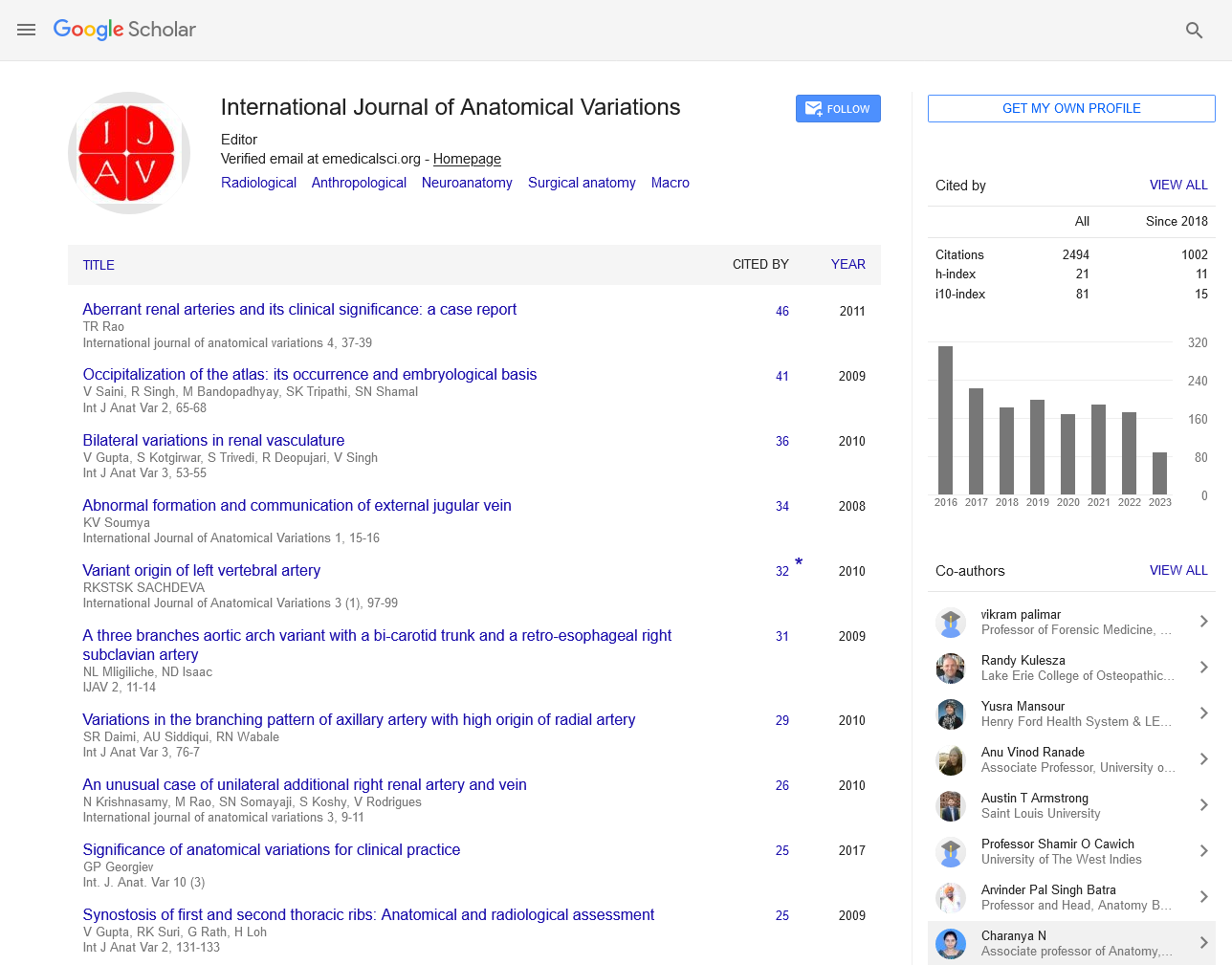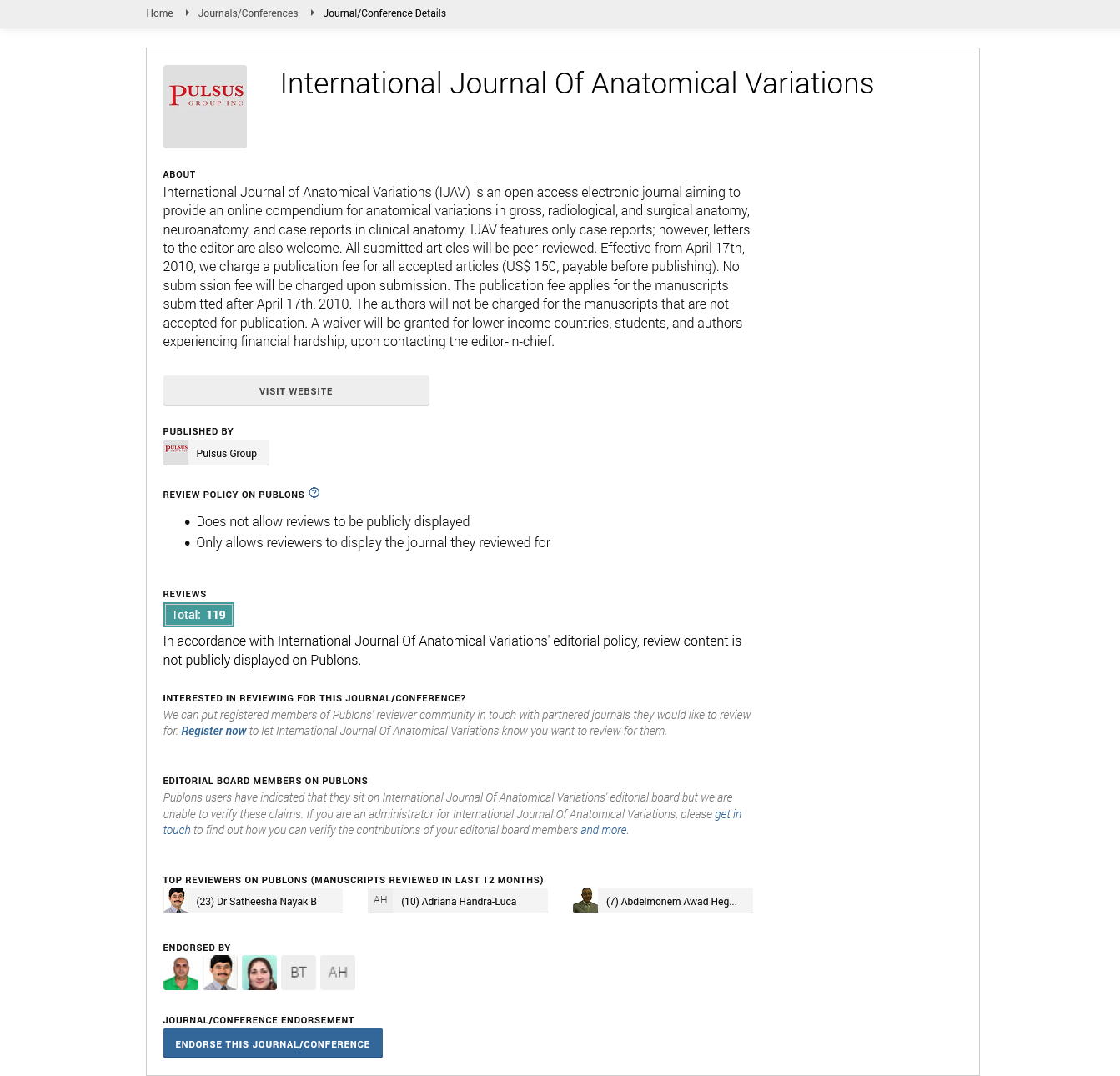Exploring Anatomical Variations from Patterns to Clinical Implications
Received: 02-Apr-2024, Manuscript No. ijav-24-7033; Editor assigned: 05-Apr-2024, Pre QC No. ijav-24-7033 (PQ); Reviewed: 23-Apr-2024 QC No. ijav-24-7033; Revised: 26-Apr-2024, Manuscript No. ijav-24-7033 (R); Published: 30-Apr-2024, DOI: 10.37532/1308-4038.17(4).383
Citation: Dick A. Exploring Anatomical Variations from Patterns to Clinical Implications. Int J Anat Var. 2024;17(4): 551-552.
This open-access article is distributed under the terms of the Creative Commons Attribution Non-Commercial License (CC BY-NC) (http://creativecommons.org/licenses/by-nc/4.0/), which permits reuse, distribution and reproduction of the article, provided that the original work is properly cited and the reuse is restricted to noncommercial purposes. For commercial reuse, contact reprints@pulsus.com
Abstract
Anatomical variations are inherent to the human body, manifesting as natural deviations from the standard anatomical features observed in textbooks and atlases. This research article delves into the complexities of anatomical variations, encompassing their prevalence, classification, underlying causes, and clinical significance. Through a multidisciplinary approach, we explore the diverse manifestations of anatomical variations across different anatomical systems and populations. Additionally, we discuss the implications of anatomical variations in clinical practice, surgical interventions, medical imaging, and medical education. By understanding the nuances of anatomical variations, clinicians and researchers can navigate the challenges posed by individual anatomical differences and optimize patient care strategies.
Keywords
Anatomical variations; Human anatomy; Classification; Clinical implications; Surgical interventions; Medical imaging; Medical education
INTRODUCTION
Anatomical variations refer to deviations from the typical anatomical structures and arrangements observed in the human body. These variations can manifest as differences in size, shape, number [1], or location of anatomical features, and they are inherent to the natural diversity among individuals. While many anatomical structures exhibit a high degree of consistency within populations, variations can occur at any level of organization, from macroscopic to microscopic scales [2]. Understanding the prevalence, classification, and clinical implications of anatomical variations is essential for healthcare professionals involved in diagnosis, treatment, and surgical interventions. This research article aims to provide a comprehensive overview of anatomical variations, exploring their manifestations, underlying causes, and implications in clinical practice and medical education [3].
PREVALENCE AND CLASSIFICATION OF ANATOMICAL VARIATIONS
Anatomical variations are ubiquitous in the human population, with studies reporting a wide range of prevalence rates depending on the anatomical structure and the methodology used for assessment. Variations can be classified based on several criteria, including their anatomical location, morphological characteristics, developmental origin, and genetic basis [4]. Common examples of anatomical variations include variations in the branching patterns of blood vessels, the presence of accessory muscles or organs, and differences in skeletal morphology such as the presence of supernumerary ribs or vertebral anomalies. Classifying anatomical variations allows clinicians and researchers to organize and categorize the diverse array of deviations observed in the human body [5-7], facilitating communication and comparison across studies and populations.
CAUSES AND MECHANISMS OF ANATOMICAL VARIATIONS
Anatomical variations arise from a combination of genetic, developmental, and environmental factors that influence the formation and patterning of anatomical structures during embryonic development and beyond. Genetic factors play a significant role in determining the basic body plan and regional identity of tissues and organs, with mutations, polymorphisms, and gene expression patterns contributing to variations in anatomical features. Developmental processes, such as morphogenesis, tissue differentiation, and cellular migration [8], shape the final form and arrangement of anatomical structures during embryonic and fetal development. Environmental factors, including intrauterine conditions, maternal nutrition, and exposure to teratogens, can also influence the development and expression of anatomical variations. Interactions between genetic and environmental factors can result in complex patterns of anatomical variation, with individual differences reflecting the unique interplay of genetic and environmental influences [9].
CLINICAL IMPLICATIONS OF ANATOMICAL VARIATIONS
Anatomical variations have significant implications for clinical practice, surgical interventions, medical imaging, and medical education. In clinical practice, awareness of anatomical variations is essential for accurate diagnosis [10], treatment planning, and prognostic assessment. Variations in anatomical structures can complicate surgical procedures, increase the risk of intraoperative complications, and impact postoperative outcomes. For example, variations in vascular anatomy can affect the feasibility and safety of surgical approaches, while variations in musculoskeletal anatomy can influence the selection of orthopedic implants and surgical techniques. In medical imaging, knowledge of anatomical variations is crucial for interpreting imaging studies, identifying incidental findings, and avoiding diagnostic errors. Variations in anatomical landmarks or structures can mimic pathological conditions or obscure the visualization of pathological abnormalities, leading to misdiagnosis or delayed treatment. In medical education, exposure to anatomical variations enhances students’ understanding of anatomical principles and prepares them to recognize and adapt to diverse anatomical presentations in clinical practice. Incorporating case-based learning, anatomical imaging, and simulationbased training can help students develop the skills and confidence needed to navigate the complexities of anatomical variations in their future careers.
SIGNIFICANCE OF HUMAN ANATOMY IN BIOMEDICAL SCIENCES
Human anatomy plays a pivotal role in biomedical sciences, providing the foundation for understanding health and disease. Anatomical knowledge is essential for medical education, enabling students to learn about the structure, function, and interrelationships of anatomical systems. Clinical practice relies on anatomical expertise for accurate diagnosis, treatment planning, and surgical intervention. Anatomical variations among individuals, such as variations in organ morphology and vascular anatomy, can have significant implications for patient care and clinical outcomes. Furthermore, research in human anatomy contributes to advancements in medical technology, therapeutic interventions, and regenerative medicine. By elucidating the underlying mechanisms of disease and injury, anatomical research informs the development of novel treatments and interventions to improve patient outcomes and quality of life.
FUTURE DIRECTIONS IN ANATOMICAL VARIATION RESEARCH
Future research on anatomical variations should focus on several key areas to advance our understanding of this complex phenomenon and its implications for clinical practice and medical education. First, there is a need for large-scale studies to characterize the prevalence and patterns of anatomical variations across diverse populations and anatomical systems. Population-based imaging studies, anatomical atlases, and cadaveric studies can provide valuable insights into the range of anatomical variation present within and between populations. Second, interdisciplinary collaborations between anatomists, geneticists, developmental biologists, clinicians, and computational scientists can elucidate the genetic and environmental factors underlying anatomical variations and their contributions to health and disease. Integrating genomic data, imaging data, and clinical outcomes can provide a comprehensive understanding of the mechanisms and consequences of anatomical variations in health and disease. Third, innovative methodologies and technologies, such as high-resolution imaging techniques, 3D modeling, and machine learning algorithms, can enhance our ability to visualize, analyze, and predict anatomical variations in clinical practice and research. By embracing these emerging trends and methodologies, researchers can address the challenges posed by anatomical variations and improve patient care strategies tailored to individual anatomical differences.
CONCLUSION
Anatomical variations are intrinsic to the human body, reflecting the inherent diversity and complexity of biological systems. Understanding the prevalence, classification, and clinical implications of anatomical variations is essential for healthcare professionals involved in diagnosis, treatment, and surgical interventions. By embracing interdisciplinary approaches and innovative methodologies, researchers can advance our understanding of anatomical variations and optimize patient care strategies tailored to individual anatomical differences. Through continued research and collaboration, we can navigate the complexities of anatomical variations and enhance our ability to provide personalized and effective healthcare for all individuals.
REFERENCES
- Fontana F, Coppola A, Ferrario L. Internal Iliac Artery Embolization within EVAR Procedure: Safety, Feasibility, and Outcome. J Clin Med. 2022; 11(24):73-99.
- Szymczak M, Krupa P, Oszkinis G, Majchrzycki M. Gait pattern in patients with peripheral artery disease. BMC Geriatrics. 2018; 18:52.
- Bleich AT, Rahn DD, Wieslander CK, Wai CY, Roshanravan SM, et al. Posterior division of the internal iliac artery: Anatomic variations and clinical applications. Am J Obstet Gynecol. 2007; 197:658.e651-658.e655.
- Chase J. Variation in the Branching Pattern of the Internal Iliac Artery. In: University of North Texas Health Science Center. Fort Worth. 2016: 1-33.
- Nayak SB, Shetty P, Surendran S, Shetty SD. Duplication of Inferior Gluteal Artery and Course of Superior Gluteal Artery Through the Lumbosacral Trunk. OJHAS. 2017; 16.
- Albulescu D, Constantin C, Constantin C. Uterine artery emerging variants - angiographic aspects. Current Health Sciences Journal 2014; 40:214-216.
- Osher M, Semaan D, Osher D. The uterine arteries, anatomic variation and the implications pertaining to uterine artery embolization. J Vasc Interv Radiol 2014; 25:S143.
- Park K-M, Yang S-S, Kim Y-W, Park KB, Park HS, et al. Clinical outcomes after internal iliac artery embolization prior to endovascular aortic aneurysm repair. Surg Today 2014; 44:472-477.
- Patel SD, Perera A, Law N, Mandumula S. A novel approach to the management of a ruptured Type II endoleak following endovascular repair of an internal iliac artery aneurysm. Br J Radiol. 2011; 84(1008):e240-2.
- Rayt HS, Bown MJ, Lambert KV. Buttock claudication and erectile dysfunction after internal iliac artery embolization in patients prior to endovascular aortic aneurysm repair. Cardiovasc Intervent Radiol. 2008; 31(4):728-34.
Indexed at, Google Scholar, Crossref
Indexed at, Google Scholar, Crossref
Indexed at, Google Scholar, Crossref
Indexed at, Google Scholar, Crossref
Indexed at, Google Scholar, Crossref
Indexed at, Google Scholar, Crossref
Indexed at, Google Scholar, Crossref






